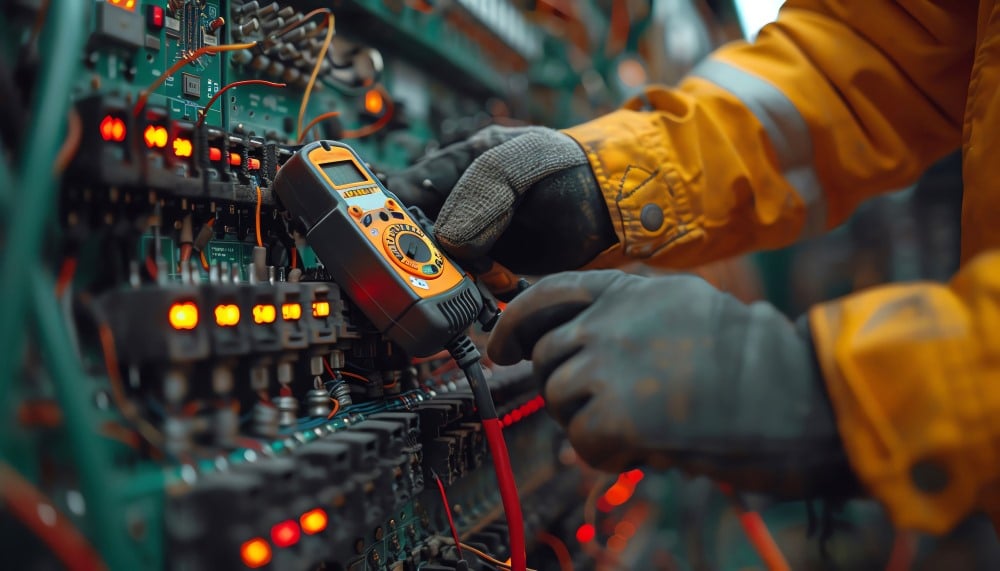
Imagine trying to have a conversation in a noisy room filled with chatter, clinking glasses, and loud music.
Now, imagine you have a magical device that can turn down the noise, amplify the voice of the person you’re talking to, and ensure you hear every word they say crystal clear.
That’s essentially what a signal conditioning circuit does for your sensors—it takes raw, often noisy data and turns it into something meaningful and precise.
Get ready as we explore the world of signal conditioning.
What is a Signal Conditioning Circuit?
It is a vital component in data acquisition systems, responsible for converting raw analog signals from sensors into a format suitable for further processing and analysis.
These circuits are essential for ensuring that signals are accurately captured, free from noise, and within the required range for the measuring instrument.
In the context of load cells, signal conditioning circuits play a critical role in translating minute changes in resistance (caused by applied force) into readable electrical signals.
What Do Signal Conditioners Do?
Signal conditioners operate by performing a variety of functions, including amplification, filtering, isolation, and linearization of sensor signals. In the case of load cells, which often produce very small voltage changes, a signal conditioning circuit amplifies these signals to levels that can be accurately measured.
The circuit also filters out noise, ensuring that only the relevant signal is processed. Additionally, electrical isolation helps prevent interference from external sources, while linearization ensures that the output accurately reflects the input, especially in non-linear sensors like strain gauges.
How the Signal Conditioning Circuit Works
- Amplification or Transformation: Boosts the small output signal from sensors like load cells to a higher voltage, making it easier to read and process and/or transforms it from a voltage signal to a current source.
- Filtering: Removes unwanted noise from the signal, ensuring the output is clean and precise.
- Isolation: Protects the measurement system from high voltage spikes and ground loops, ensuring accurate readings.
- Linearization: Corrects non-linear output from sensors, providing a proportional and accurate signal corresponding to the measured parameter.
What Are the Different Types of Signal Conditioning Circuits?
Signal conditioning circuits are designed to prepare sensor outputs for accurate measurement and analysis. They can be categorized based on their specific functions:
- Amplifiers: Increase the amplitude of low-level signals from sensors like load cells, making them easier to process. Types include instrumentation amplifiers and differential amplifiers.
- Filters: Remove unwanted noise from the signal. Low-pass, high-pass, and band-pass filters are common, depending on the frequency range of interest.
- Isolators: Provide electrical isolation between different parts of the system to protect against voltage spikes and ground loops, ensuring the integrity of the signal.
- Excitation Circuits: Supply the necessary voltage or current to active sensors, such as strain gauges or thermocouples, enabling them to generate measurable signals.
- Analog-to-Digital Converters (ADC): Convert analog signals into digital data for processing in microcontrollers or computers. ADCs are often integrated into signal conditioning circuits to digitize the conditioned signals.
- Linearizers: Correct non-linear signals, ensuring a proportional and accurate output relative to the sensor input. This is particularly important in sensors that do not have a linear output, such as certain thermocouples or strain gauges.
- Temperature Compensation Circuits: Adjust signals to account for temperature variations, maintaining measurement accuracy in changing environmental conditions.
Each type of circuit addresses a specific challenge in signal measurement, ensuring that the data obtained from sensors is accurate, reliable, and ready for further analysis.
Load Cell Signal Conditioning
Load cell signal conditioning circuits are specialized to handle the low-level signals from strain gauges.
They typically include precise amplifiers and low-pass filters to deal with noise and ensure the output accurately reflects the force or weight being measured.
Key Considerations When Building a Signal Conditioning System
When designing a signal conditioning system, especially for load cells, consider the following:
- Accuracy: Ensure the system provides high precision and minimal error in the signal conversion process.
- Temperature Stability: Select components that can operate reliably across varying temperatures, as load cells often function in diverse environments.
- Noise Reduction: Incorporate filtering techniques to eliminate interference, crucial for maintaining signal integrity.
- Linearity: Choose circuits that offer linear output across the entire measurement range to ensure accurate data.
Signal Conditioning Circuits Applications
Signal conditioning circuits are crucial across various industries, ensuring accurate data measurement and processing in different applications:
Industrial Weighing Systems
- Industries: Manufacturing, batch processing, food and beverage, logistics, agriculture.
- Applications: Weighing systems for production lines, material mixing, bulk material handling, inventory management
Pressure Measurement
- Industries: Oil and gas, chemical processing, automotive.
- Applications: Monitoring hydraulic systems, controlling process pressures, ensuring safety in pressurized environments.
Temperature Monitoring
- Industries: Power generation, HVAC, pharmaceuticals.
- Applications: Precise temperature control in reactors, climate control systems, and quality assurance during production.
Vibration Analysis
- Industries: Aerospace, civil engineering, heavy machinery.
- Applications: Structural health monitoring, predictive maintenance of machinery, testing of aircraft components.
Load Cell Applications
- Industries: Transportation, mining, construction.
- Applications: Truck scales, crane load monitoring, hopper weighing for materials like cement or aggregates.
Medical Instrumentation
- Industries: Healthcare, medical devices.
- Applications: Monitoring patient vitals with precision, ensuring safety in medical equipment operation.
Automotive Testing
- Industries: Automotive manufacturing, motorsports.
- Applications: Testing vehicle components under stress, measuring forces in crash testing, and ensuring the reliability of safety systems.
Environmental Monitoring
- Industries: Environmental science, agriculture.
- Applications: Measuring environmental parameters like wind speed, soil moisture, and air quality for data-driven decision-making.
When integrating signal conditioning circuits into these applications, industries can achieve higher accuracy, reliability, and efficiency in their operations, particularly when working with sensitive sensors like load cells and strain gauges.
Implementing a Signal Conditioning System for Load Cells and Strain Gauges
To implement a signal conditioning system for load cells:
- Choose the Right Amplifier: A high-quality, low-noise amplifier that can boost the microvolt signals from the strain gauges is essential.
- Ensure Proper Filtering: Use low-pass filters to remove high-frequency noise that can distort the signal.
- Incorporate Excitation Voltage: Provide a stable excitation voltage to the load cell to ensure consistent and accurate measurements.
- Calibrate Regularly: Regular calibration of the signal conditioning system is necessary to maintain accuracy over time.
Signal conditioning circuits are the backbone of accurate data acquisition, ensuring that every detail captured by your sensors is clean, precise, and ready for analysis.
As you delve deeper into the world of load cells and signal conditioning, remember that mastering these fundamentals can significantly enhance your system’s performance.
Curious to learn more? Explore our other articles to expand your knowledge and discover how Massload’s innovative solutions can elevate your operations. If you have any questions about integrating signal conditioning into your systems, feel free to contact us.


